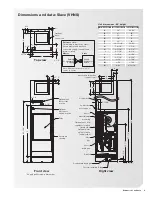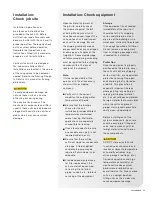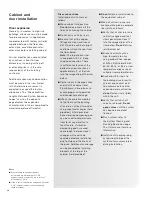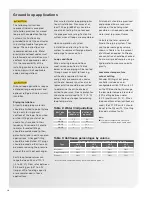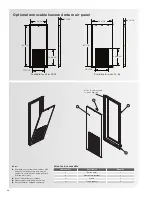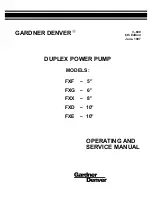
19
Applications
Proper maintenance of the
water loop is critical to both the
efficiency and longevity of the
system. This includes cleaning,
flushing and chemical treatment.
Three categories of issues can
arise from use of water including:
■
■
Scale formation:
resulting
from crystallization of
dissolved salts in the water.
These deposits form a
water-side insulation layer
that reduces heat transfer,
increases pressure drop and
may reduce flow.
■
■
Metal decay:
resulting from
corrosion or erosion
■
■
Organic growths:
slime and
algae can form under certain
environmental conditions. These
growths can have multiple adverse
impacts including reduced heat
transfer, increased pressure drop,
reduced flow and corrosion.
System water should be evaluated
for impurities. Testing is available
from independent labs, health
departments and/or state agencies.
Table 6 provides a list of water
characteristics, potential impurities
and effects and recommended
treatments.
Water quality standards
Table 5: Water characteristics
Impurity
Copper coils
Cupro-nickel
coils
Result
Application
Open recirculating
Closed recirculating
Calcium and
magnesium salts
(hardness)
<350 PPM
350 PPM sea
water
Scaling
1. Bleed off
2. Surface active agents such
as polyphosphates
3. Addition of acid
4. pH adjustment
No treatment required
Iron oxide
Low levels only Moderate levels
Corrosion
1. Corrosion inhibiters
2. pH control
3. Proper materials of
construction
1. Corrosion inhibiters
(high concentrations)
2. Proper materials of
construction
pH
6.5 - 7.5
5 - 10
Hydrogen sulfide
<10 PPM
10-50 PPM
CO
2
<50 PPM
50-75 PPM
Chloride
<300 PPM
300-600 PPM
Total dissolved solids
<100 PPM
1000-1500 PPM
Slime and algae
Slime and algae can form under
certain environmental conditions
Reduced heat transfer
due to forming of
insulating coating or
pitting due to corrosion
1. Chlorinated phenols
2. Other biocides
3. Chlorine by hypochlorites ot
by liquid chlorine
No treatment required
Notes:
■
■
Water quality varies widely from locale to locale. Consult a local water treatment specialist for specific treatment recommendations.
■
■
Cupro-nickel is recommended if iron bacteria, suspended solids, or dissolved oxygen is high.
■
■
If concentration of corrosives exceeds Cupro-nickel maximums the potential for serious corrosion problems exist.
Potential problems can be
mitigated by:
■
■
Using cupro-nickel coils
■
■
Maintaining flow rates of
<4 GPM per ton to minimize
potential erosion
The Zehnder Rittling Water
Quality Table provides water
quality requirements for Zehnder
Rittling coaxial heat exchangers.
When water properties are
outside of those requirements,
an external secondary heat
exchanger must be used to
isolate the heat pump heat
exchanger from the unsuitable
water. Failure to do so will void
the warranty for the coaxial heat
exchanger.





